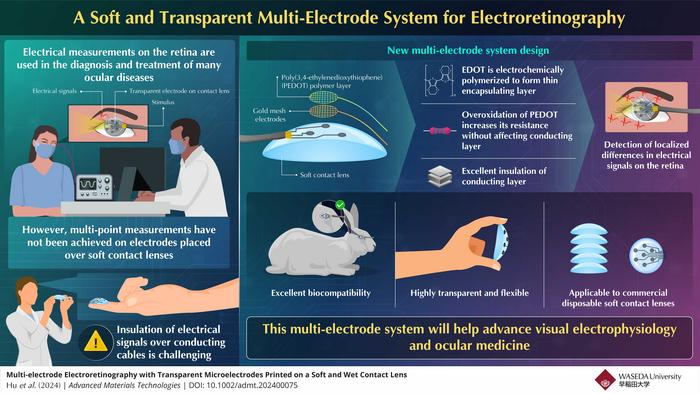Eye diseases are becoming more prevalent worldwide, partly because of the aging population, but also because of our greatly increased screen time compared to previous generations. Considering our use of displays will most likely keep rising due to technologies such as virtual and augmented reality, we must improve our diagnostic techniques for the early detection and monitoring of ocular diseases.

Credit: Cannot be reused without permission
Eye diseases are becoming more prevalent worldwide, partly because of the aging population, but also because of our greatly increased screen time compared to previous generations. Considering our use of displays will most likely keep rising due to technologies such as virtual and augmented reality, we must improve our diagnostic techniques for the early detection and monitoring of ocular diseases.
Among the arsenal of tools ophthalmologist have at their disposal, electroretinography (ERG) still holds much-untapped potential. Simply put, ERG consists of taking measurements of the electrical potentials generated by neurons and other cells in the retina from the surface of the cornea. Many ocular diseases cause abnormalities in a person’s ERG signals, including glaucoma, retinitis pigmentosa, and diabetic retinopathy. Although many types of ERG measurement devices exist, few ERG electrodes can measure multiple localized ERG signals from different regions of the retina at the same time. In most cases, such measurements are performed using electrodes placed on hard contact lenses. This makes the procedure more complex, expensive, and particularly uncomfortable for the patient.
Against this background, a research team led by Professor Takeo Miyake from the Graduate School of Information, Production and Systems at Waseda University, Japan, set out to develop a new type of soft ERG multi-electrode system to overcome these issues. Their latest study, published in Advanced Materials Technologies on May 7, 2024, describes their findings. It was co-authored by Saman Azhari from the Graduate School of Information, Production and Systems at Waseda University, as well as Atsushige Ashimori and Kazuhiro Kimura from the Department of Ophthalmology at Yamaguchi University.
The proposed system utilizes a commercially available soft disposable contact lens. The researchers first immersed this contact lens in a solution containing the monomer 3,4-ethylenedioxythiophene (EDOT). They then placed carefully designed gold mesh electrodes with their respective connecting wires onto the inner surface of the contact lens. By circulating a current through the solution containing EDOT, the monomers formed an entangled polymer called PEDOT, which adhered well to the contact lens and fixated the gold components.
A key advantage of this approach is that the PEDOT layer can be overoxidized by using a DC voltage under dry condition, thereby forming a highly insulating layer on the collecting wire. This insulation is critical to ensure different retinal signals flowing through the gold wires do not interfere with one another or with signals originating from other regions of the eye. By carefully designing the gold mesh of the electrodes to spread currents during overoxidation process, the PEDOT encapsulating the mesh region does not overoxidize, thus ensuring good electrical contact with the eye.
The result of this innovative process is a flexible and highly transparent multi-electrode system for ERG measurements that is just as comfortable as commercial disposable contact lenses. The researchers carefully examined the optoelectrical properties of their multi-electrodes and also conducted some experiments on rabbits, as Miyake comments: “Our device was used in animal experiments, confirming its biocompatibility and suggesting a correlation between the location of the electrodes and the intensity of the recorded ERG signals. In other words, our design could enable precise spatial measurements of multiple ERG signals simultaneously.”
Taken together, the findings of this study would help us better understand and diagnose ocular diseases. “The use of augmented and virtual reality devices is growing quickly, and the precise and continuous monitoring of eye conditions will become a necessity,” remarks Miyake. “A smart contact lens such as the one developed in this work could be connected to a local network to transmit the eye’s health condition to an ophthalmologist or healthcare specialist while the user is performing their daily routine. Such systems could prevent irreparable damage to the eyes.”
***
Reference
Authors: Lunjie Hu1, Saman Azhari1, Qianyu Li1, Hanzhe Zhang1, Ashimori Atsushige2, Kimura Kazuhiro2, and Takeo Miyake1,3
Title of original paper: Multi-electrode Electroretinography with Transparent Microelectrodes Printed on a Soft and Wet Contact Lens
Journal: Advanced Materials Technologies
DOI: https://doi.org/10.1002/admt.202400075
Affiliations
1Graduate School of Information, Production and Systems, Waseda University
2Department of Ophthalmology, Yamaguchi University
3PRESTO, Japan Science and Technology Agency
About Waseda University
Located in the heart of Tokyo, Waseda University is a leading private research university that has long been dedicated to academic excellence, innovative research, and civic engagement at both the local and global levels since 1882. The University has produced many changemakers in its history, including nine prime ministers and many leaders in business, science and technology, literature, sports, and film. Waseda has strong collaborations with overseas research institutions and is committed to advancing cutting-edge research and developing leaders who can contribute to the resolution of complex, global social issues. The University has set a target of achieving a zero-carbon campus by 2032, in line with the Sustainable Development Goals (SDGs) adopted by the United Nations in 2015.
To learn more about Waseda University, visit https://www.waseda.jp/top/en
About Professor Takeo Miyake
Dr. Takeo Miyake currently serves as a Professor and Associate Dean at Waseda University. He received B.S., M.S., and Ph.D. degrees from Waseda University between the years 2004 and 2008. His research is centered around the development of safe and soft bioelectronics that form seamless interfaces between devices and humans, and he has been actively researching and developing smart contact lenses for eye health monitoring and protection. Dr. Miyake believes that, soon, smart contact lens devices will become a tangible and inseparable part of modern humans, and thus wishes to be a pioneer in this movement.
Journal
Advanced Materials Technologies
DOI
10.1002/admt.202400075
Method of Research
Experimental study
Subject of Research
Not applicable
Article Title
Multi-electrode Electroretinography with Transparent Microelectrodes Printed on a Soft and Wet Contact Lens
Article Publication Date
7-May-2024
COI Statement
The authors declare no conflict of interest.




